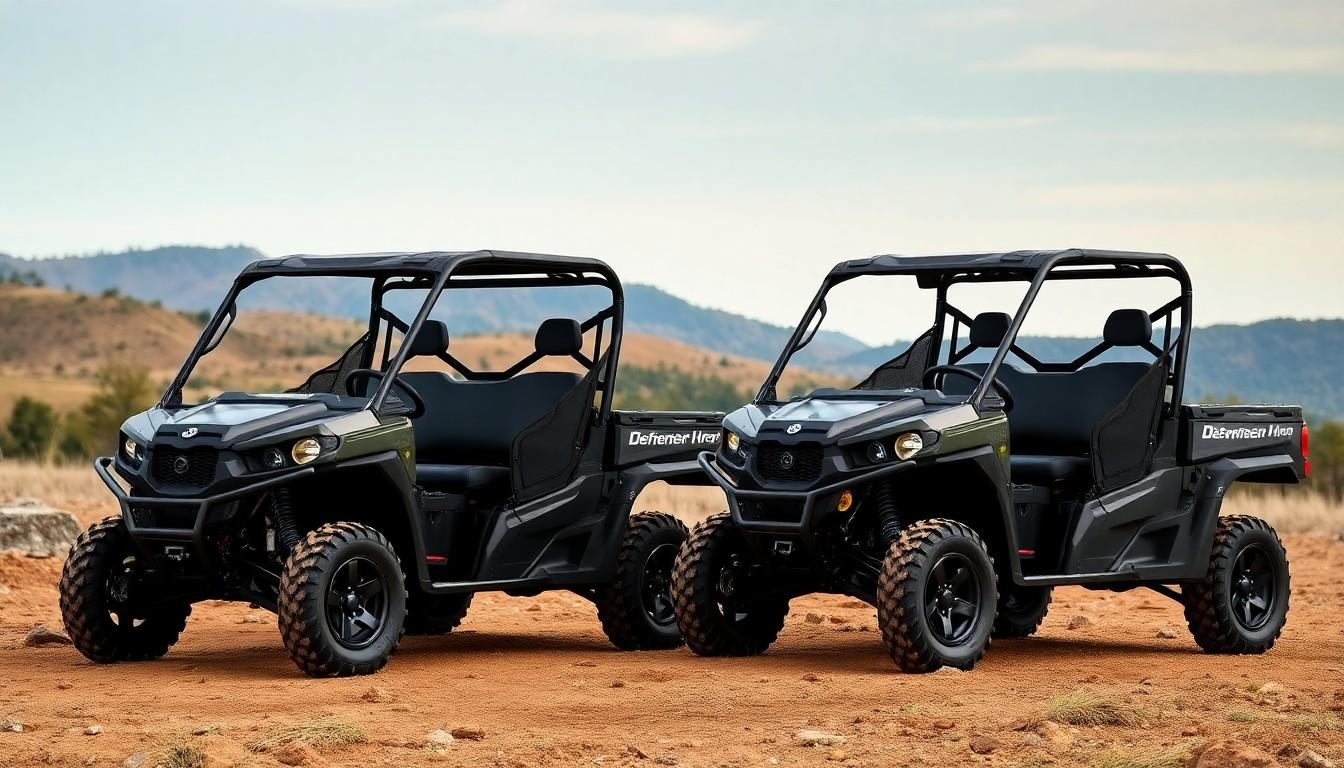Choosing between the Can-Am Defender HD9 and HD10 isn’t just a matter of preference—it’s about finding the perfect balance of power, performance, and value for your exact needs. As off-road enthusiasts ourselves, we’ve tested both models extensively to help you make an well-informed choice.
When comparing these two popular UTVs, the differences extend beyond just engine displacement. From torque and towing capacity to price point and fuel efficiency, each model offers distinct advantages that could make it the ideal choice for your adventures. Whether you’re working on a ranch, tackling challenging trails, or simply seeking weekend excitement, understanding these key differences is crucial.
Understanding Can-Am Defender HD9 vs HD10 Models
The Can-Am Defender HD9 and HD10 models represent two distinct performance tiers in Can-Am’s popular UTV lineup. Both vehicles share the same chassis and many components, but critical differences in their powertrains create unique performance profiles for each model. The HD9 features a 65 horsepower Rotax 900cc engine, while the HD10 comes equipped with an 82 horsepower Rotax 976cc powerplant.
Performance distinctions between these models extend beyond raw horsepower numbers. Torque production varies significantly, with the HD10 generating 69 lb-ft compared to the HD9’s 59 lb-ft, creating noticeable differences in pulling power and acceleration. Towing capacity remains identical at 2,500 pounds for both models, though the HD10’s additional power helps maintain performance when hauling heavy loads.
Price considerations often drive purchasing decisions between these two models. The HD9 typically costs $1,500-$2,000 less than comparable HD10 configurations, making it an attractive option for budget-conscious buyers. This price gap represents approximately 10-15% of the total vehicle cost, depending on the exact trim level and accessories.
Fuel efficiency differs slightly between the two engines. The HD9’s smaller displacement generally delivers 10-15% better fuel economy during typical usage scenarios. This efficiency advantage can translate to meaningful savings for high-usage commercial applications or extended recreational trips where refueling options may be limited.
Reliability metrics show both engines perform exceptionally well under normal operating conditions. The HD9’s simpler design with fewer moving parts potentially offers marginally better long-term dependability, though both powerplants boast impressive durability records across various work environments and recreational applications.
Engine Performance and Power Comparison
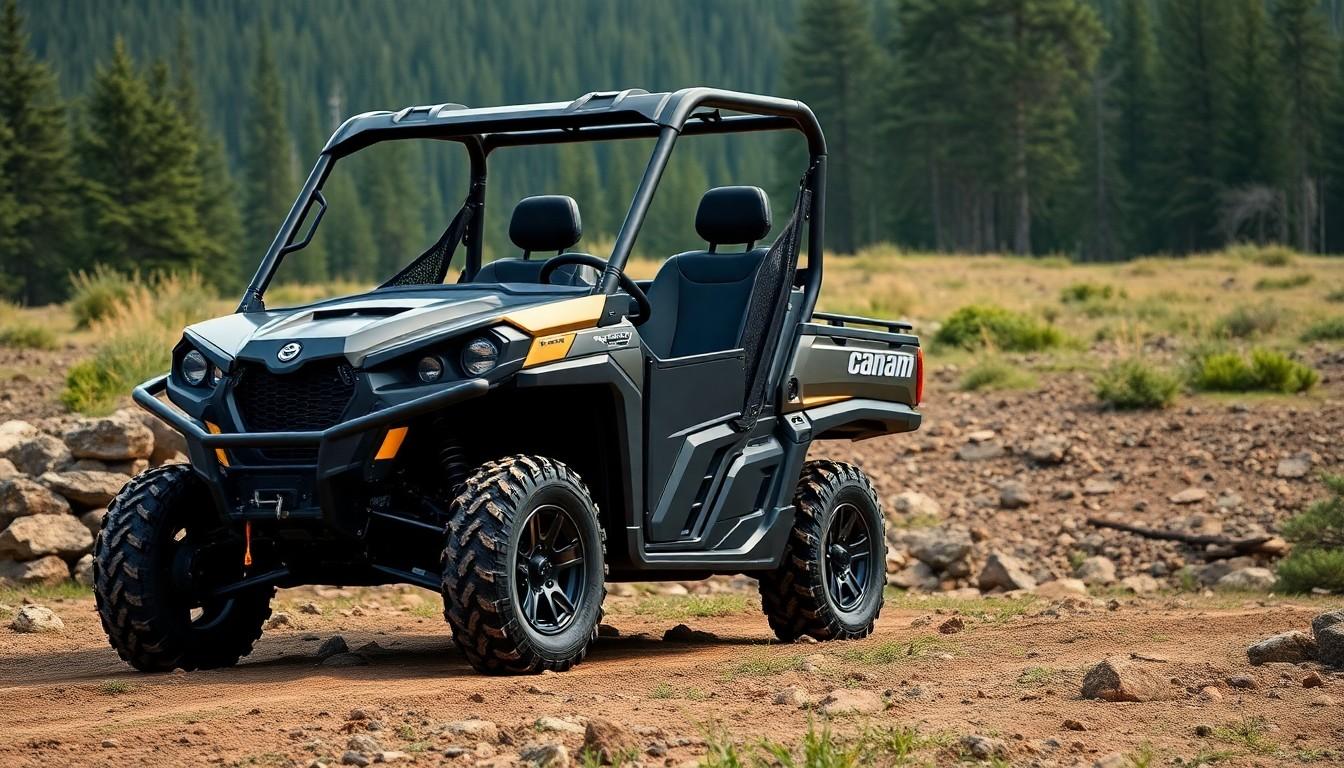
The Can-Am Defender HD9 and HD10 models feature distinct performance profiles even though their similar appearances. These differences primarily stem from their engine specifications and real-industry capabilities.
HD9 Engine Specifications
The Can-Am Defender HD9 comes equipped with a Rotax 976cc V-twin engine delivering 65 horsepower from the factory. This power plant provides sufficient output for most standard utility tasks and moderate recreational riding. Its engine configuration is comparable to the pre-2020 HD10 motors, offering a balanced performance profile for everyday use.
HD10 Engine Specifications
The Can-Am Defender HD10 features the same Rotax 976cc V-twin engine architecture but with important performance enhancements. It generates 82 horsepower from the factory, representing a 17 horsepower advantage over the HD9. The 2020 and newer HD10 models incorporate Maverick heads and an improved intake system that aren’t present in the HD9 version.
Real-Industry Performance Differences
Power output creates the most noticeable distinction between these models, with the HD10’s 82 horsepower providing superior acceleration and top-end performance compared to the HD9’s 65 horsepower. This additional power makes the HD10 particularly well-suited for demanding off-road conditions and heavy-duty work applications.
Engine enhancements in the HD10 extend beyond raw horsepower numbers. The upgraded heads and intake system optimize airflow and combustion efficiency, resulting in more responsive throttle behavior and better high-RPM performance.
Performance capabilities vary considerably between the two models in challenging situations. The HD10 offers advanced drivetrain options for enhanced traction control, making it more versatile across various terrains and conditions. While still capable, the HD9 might not satisfy users seeking maximum power and advanced performance features.
Modifications can significantly impact the HD9’s performance potential. An ECU power flash can boost its output, though this requires aftermarket modifications that affect warranty coverage. Even with modifications, the stock HD10 typically maintains its performance advantage in most situations.
Towing and Payload Capacities
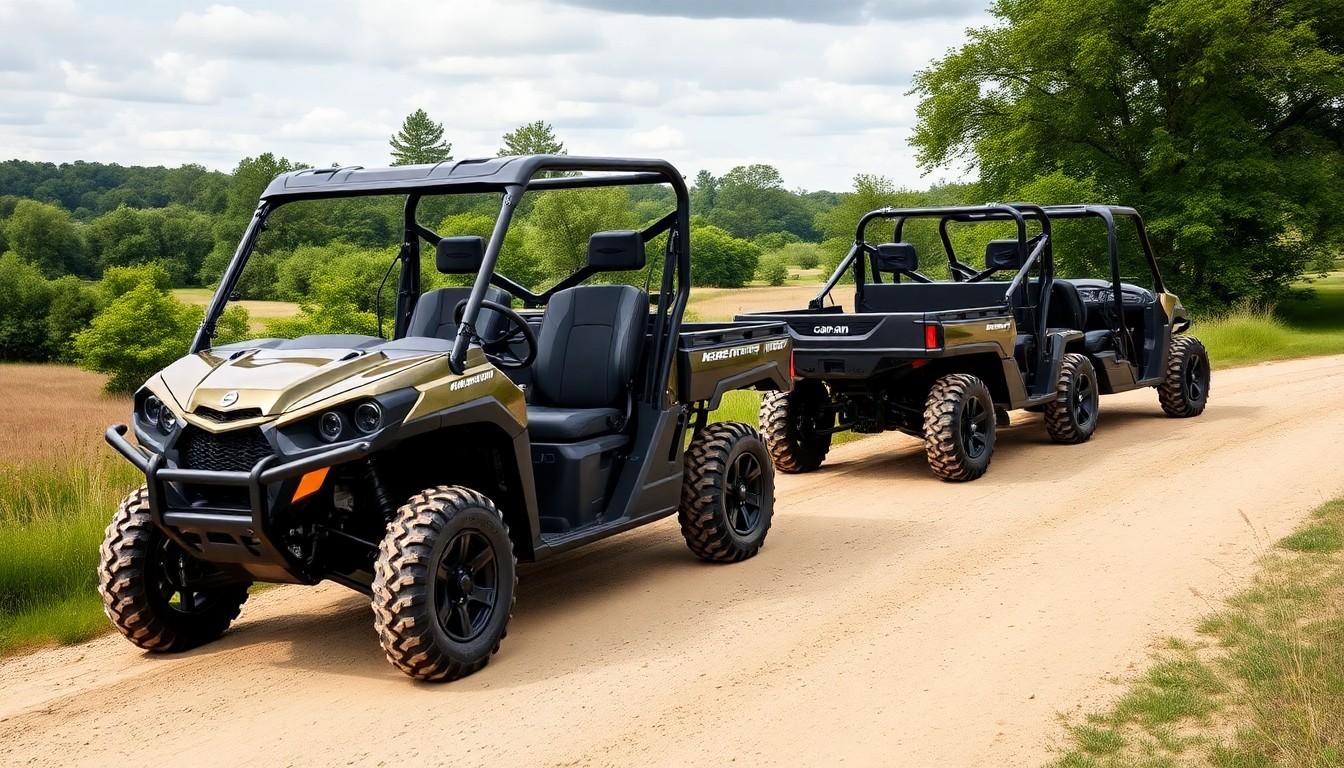
Both the Can-Am Defender HD9 and HD10 offer impressive capabilities when it comes to hauling and transporting heavy loads. These utility vehicles share similar specifications in this department, making either choice viable for those who need a reliable workhorse for their projects.
HD9 Work Capabilities
The HD9 comes equipped with a powerful Rotax 976cc V-twin engine that generates 65 HP, providing sufficient power for most work-related tasks. Its suspension system features a dual A-arm front and Torsional Trailing Arm (TTA) rear with external sway bar, delivering 10 inches of travel at both ends for stable performance while carrying loads. The HD9’s combination of power and agility makes it particularly suited for users who need to navigate tighter spaces while still maintaining substantial work capacity. Many owners appreciate the HD9’s balance of affordability and functionality, especially when the full power of the HD10 isn’t necessary for their exact applications.
HD10 Work Capabilities
The HD10 utilizes the same 976cc V-twin engine platform but with enhanced performance components that boost output to 82 HP, offering additional power for the most demanding tasks. Its suspension setup includes an arched double A-arm front and arched TTA rear with external sway bar, providing an extra inch of travel (11 inches total) compared to the HD9, which translates to better handling under heavy loads. The HD10’s advanced drivetrain options deliver superior traction control, making it exceptionally capable when moving heavy loads across challenging terrain. Several customizable options are available for the HD10, allowing owners to tailor their vehicle to exact work requirements that might exceed the HD9’s capabilities.
Price Point and Value Analysis
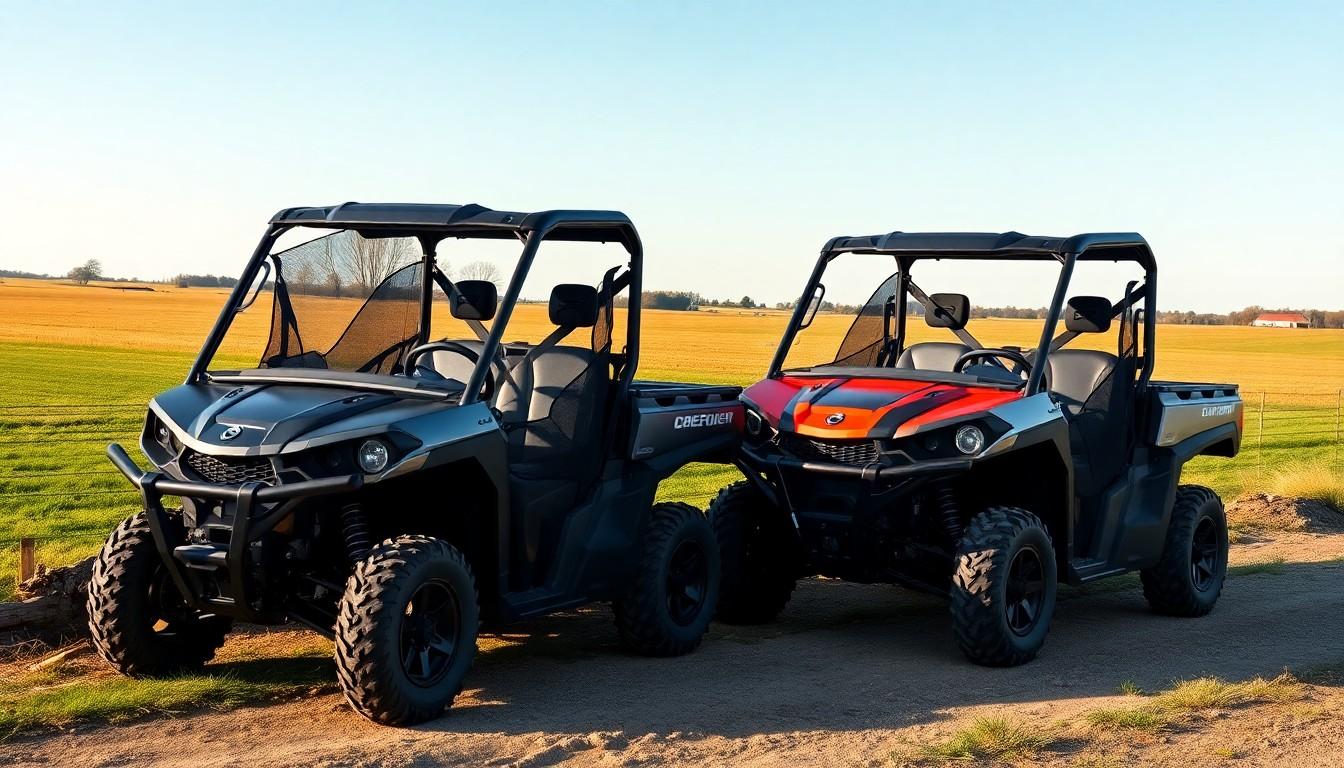
The Can-Am Defender HD9 offers a more budget-friendly entry point compared to the HD10, with a typical price difference of $1,500-$2,000. Financial considerations often make the HD9 an attractive option for buyers who don’t require the maximum power output of the higher-end model. Many farmers and recreational riders find the HD9’s balance of performance and affordability perfectly suited to their needs.
Price reflects the performance gap between these two models, with the HD10’s higher cost directly tied to its enhanced 82 HP output versus the HD9’s 65 HP. This power difference translates to real-industry utility, especially for users handling heavy loads or tackling challenging terrain regularly. Professionals who depend on their UTVs daily typically consider the HD10’s premium features worth the investment.
Value assessment extends beyond the initial purchase price to include long-term operational costs. The HD9’s approximately 10-15% better fuel efficiency creates important savings for high-usage scenarios, offsetting some of the performance advantages of the HD10. Maintenance requirements remain similar between both models, though the HD9’s simpler design potentially offers marginally better long-term reliability.
Customization options add another dimension to the value equation. The HD10 comes with more advanced drivetrain options and traction control systems that benefit exact work environments. Users can modify the HD9 with aftermarket enhancements like an ECU power flash to increase performance, narrowing the capability gap while maintaining a lower overall investment.
Both models deliver exceptional value within their respective price brackets, making the choice primarily dependent on exact usage patterns and requirements rather than overall quality differences. Commercial operations typically gravitate toward the HD10’s premium capabilities, while individual owners often find the HD9 provides sufficient performance for their mixed recreational and utility needs.
Design and Comfort Features

The Can-Am Defender HD9 and HD10 models showcase distinctive design elements that impact their overall performance and rider comfort. Both models offer robust construction with key differences in engine capabilities, suspension systems, and additional features that cater to different types of riders.
The HD9 and HD10 both use a Rotax 976cc V-twin engine, but with important performance variations. While the HD9 delivers a respectable 65 HP, the HD10 steps up with a more powerful 82 HP output, providing enhanced acceleration and hauling capabilities. Suspension systems differ as well, with the HD9 featuring a dual A-arm front suspension paired with a torsional trailing arm rear suspension. The HD10 upgrades to an arched double A-arm front suspension that offers improved articulation and stability over challenging terrain.
Cabin Space and Ergonomics
Cabin comfort remains consistent across both the Defender HD9 and HD10 models, with passenger accommodations designed for practical utility. Both UTVs can transport passengers safely, though there’s a requirement that all passengers must be at least 12 years old and physically able to hold the hand grips while keeping their feet planted on the floor and backs against the seat.
The seating position is engineered for extended comfort during long work days or recreational outings. Driver controls are positioned within easy reach in both models, with intuitive dashboard layouts that keep essential information visible at a peek. Storage compartments are strategically placed throughout the cabin, allowing for convenient access to personal items and work tools.
Available Trims and Options
The Can-Am Defender lineup consists of three main trim levels: HD7, HD9, and HD10, each targeting exact user needs and preferences. The HD9 positions itself as a versatile workhorse that balances power and utility at a more accessible price point. This mid-tier option appeals to those who need reliable performance without the premium cost of the top-end model.
The HD10 trim offers enhanced customization options and premium features designed for professionals and serious enthusiasts. Advanced drivetrain options provide better performance in challenging conditions, while improved traction control systems deliver more confidence on varied terrain types. The price difference between models reflects these enhancements, with the HD10 commanding approximately $1,500-$2,000 more than the HD9. This premium is justified for users who require maximum power and capability, particularly those using their UTVs for demanding professional applications.
Terrain Performance and Handling
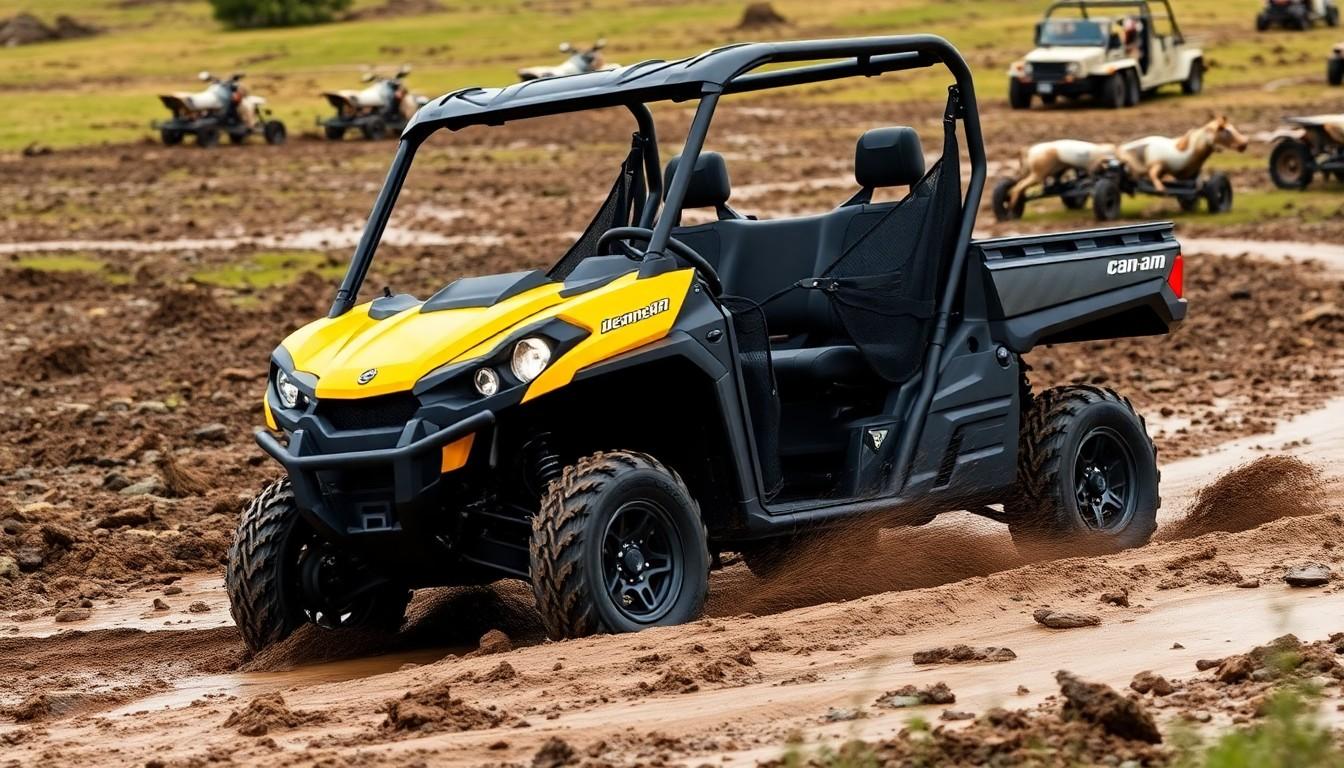
The Can-Am Defender HD9 and HD10 demonstrate important differences in how they handle various terrains. These differences stem from their unique suspension systems, ground clearance capabilities, and overall stability features.
Suspension System Performance
The HD9 comes equipped with a double A-arm front suspension offering 10 inches of travel, providing solid performance across moderate terrain challenges. In contrast, the HD10 features an enhanced arched double A-arm front suspension with 11 inches of travel, delivering superior absorption of rough terrain impacts. Both models use the Torsional Trailing Arm (TTA) rear suspension design, but the HD10 maintains its advantage with 11 inches of rear travel compared to the HD9’s 10 inches. This additional inch of suspension travel translates to noticeably smoother rides when traversing obstacles or uneven surfaces.
Ground Clearance and Stability
Ground clearance represents a key differentiator between these two models in the Defender lineup. The HD10’s arched A-arm design creates improved clearance over rocks, logs, and other obstacles that might challenge the HD9. This architectural difference gives the HD10 a distinct advantage when handling particularly challenging terrains where bottom-out risk increases. Stability during cornering and on side slopes also benefits from the HD10’s suspension geometry, allowing drivers to maintain better control in situations where the HD9 might feel less planted.
Farm and Ranch Applications
For agricultural and ranch work environments, the terrain handling capabilities of these vehicles directly impact productivity. The HD10’s combination of 82 horsepower and superior suspension travel makes it exceptionally capable when hauling heavy loads across rough pastures or muddy work sites. Farm operations requiring frequent navigation of ditches, creek crossings, or uneven ground benefit substantially from the HD10’s enhanced ground clearance and stability characteristics. The HD9, with its respectable 65 horsepower output, handles typical farm tasks competently but may require more careful navigation in extremely challenging conditions.
Trail and Recreation Comparison
Trail enthusiasts will notice meaningful performance differences between these models during recreational use. The HD10’s additional suspension travel creates a more comfortable ride experience during extended trail sessions, reducing driver fatigue on rocky or rutted paths. Shock absorption quality becomes particularly apparent when hitting trail obstacles at speed, with the HD10 maintaining composure in situations where the HD9 might reach its suspension limits. Recreational riders seeking maximum trail capability often gravitate toward the HD10 for its ability to handle aggressive driving styles while maintaining stability and control across diverse terrain types.
Maintenance and Reliability Expectations

The maintenance requirements for the Can-Am Defender HD9 and HD10 share similarities due to their common platform, though several key differences exist. Both models use the same 976cc V-twin Rotax engine architecture, creating a foundation for comparable reliability profiles. The HD10’s higher output of 82 HP compared to the HD9’s 65 HP suggests more frequent maintenance intervals for components subjected to increased stress.
Engine Longevity Differences
Engine longevity considerations reflect the performance variations between these two models. The HD9’s lower power output typically translates to reduced internal component stress, potentially extending service intervals for spark plugs, air filters, and oil changes. Conversely, the HD10’s enhanced performance demands more vigilant maintenance schedules to ensure optimal operation under higher power demands.
Suspension System Durability
The suspension systems demonstrate distinct maintenance profiles between the two models. The HD9 features a conventional dual A-arm front suspension paired with a torsional trailing arm rear configuration. The HD10 employs an arched double A-arm front suspension with the same rear design, offering better durability for challenging terrain but requiring more sophisticated service procedures when maintenance becomes necessary.
Maintenance Costs and Frequency
Maintenance costs directly correlate with each model’s complexity and performance capabilities. The HD9’s simpler design generally results in lower routine service expenses and less frequent specialized attention. The HD10’s advanced features—including more sophisticated traction control systems and higher-performance components—require more comprehensive maintenance protocols even though their contribution to improved handling and control.
Real-Industry Reliability Considerations
Real-industry reliability observations indicate both models perform dependably under appropriate use conditions. The HD10’s additional power proves advantageous for heavy-duty applications by reducing strain during demanding tasks like towing near capacity limits. This operational advantage potentially offsets its higher maintenance requirements by minimizing overexertion scenarios that commonly lead to premature component failure.
Parts Availability and Service Support
Parts availability remains consistent across both models due to Can-Am’s established dealer network and standardized component design philosophy. The shared platform between the HD9 and HD10 creates manufacturing efficiencies that benefit owners through improved parts accessibility and uniform service procedures for many maintenance operations.
Which Can-Am Defender Is Right for You?
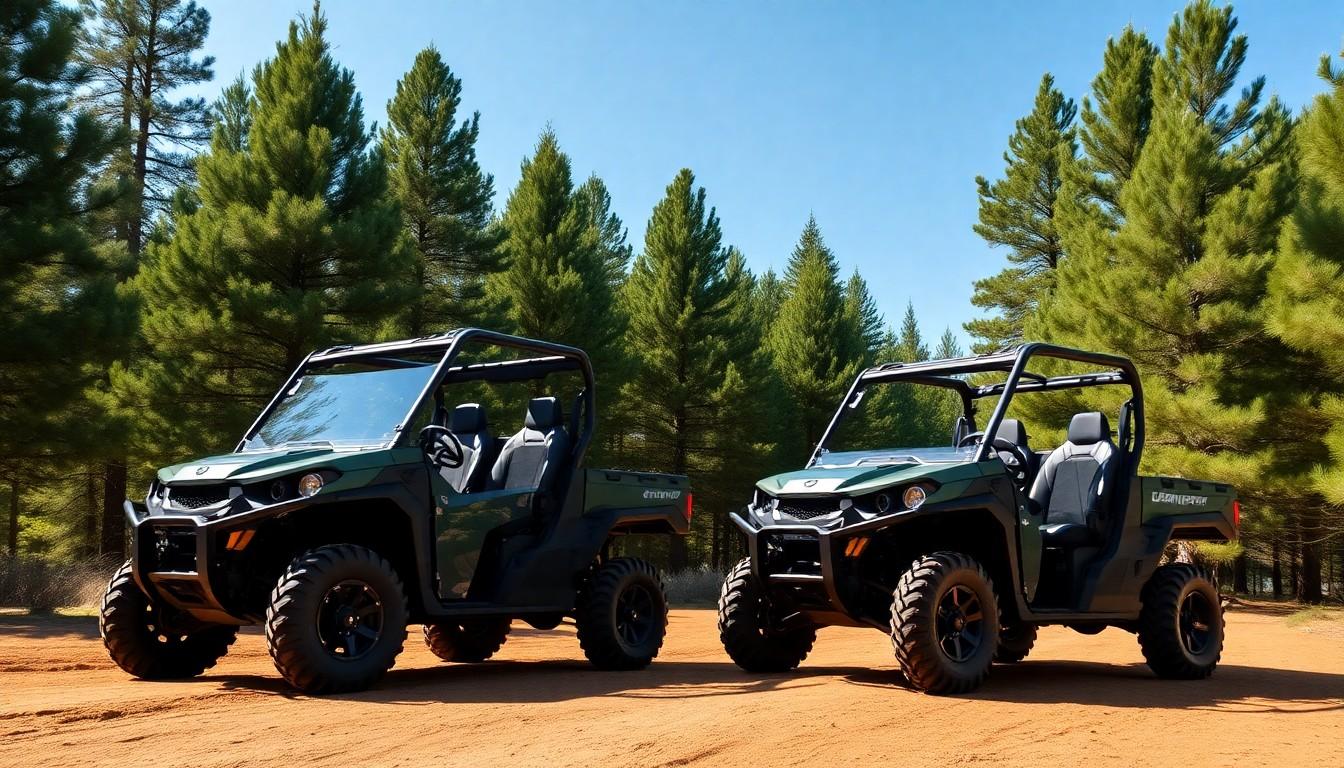
For Work-Related Usage
Work requirements determine which Defender model best suits your needs. The HD9 with its 65 HP Rotax engine handles moderate workloads efficiently while maintaining better fuel economy. Farmers and property managers with lighter hauling needs find the HD9’s balance of power and affordability ideal for daily tasks. Construction professionals requiring maximum towing performance benefit from the HD10’s enhanced 82 HP output when regularly moving heavy materials. Ranch owners appreciate the HD10’s superior ground clearance and advanced suspension system for handling rough terrain between pastures.
For Recreational Use
Recreational riders have distinct preferences based on their riding style. Trail enthusiasts often prefer the HD10’s additional suspension travel (11 inches vs 10 inches) for smoother rides over rough terrain. Weekend warriors who occasionally venture off-road find the HD9’s capabilities more than sufficient while appreciating its 10-15% better fuel efficiency. Adventure seekers tackling challenging landscapes benefit from the HD10’s superior traction control and arched double A-arm front suspension. Family-oriented riders focused on comfortable exploration typically find the HD9’s performance adequate while saving $1,500-$2,000 compared to the HD10.
Budget Considerations
Budget plays a crucial role in the decision-making process. Entry-level buyers gain excellent value from the HD9’s lower price point without sacrificing essential capabilities. Professional users often justify the HD10’s higher investment through its enhanced performance features and superior power output. Long-term owners calculating total ownership costs sometimes prefer the HD9’s improved fuel efficiency and potentially simpler maintenance requirements. Business operators frequently choose models based on exact work requirements rather than initial purchase price, making the HD10 attractive even though its premium positioning.
Terrain and Environment Factors
Your typical operating environment significantly impacts which model performs best. The HD10 excels in mountainous regions where its additional horsepower provides crucial climbing power and control. Flat terrain operations rarely require the HD10’s advanced capabilities, making the HD9 a more economical choice. Muddy conditions benefit from the HD10’s enhanced traction systems and ground clearance advantages. Forest trails with tight spaces and obstacles may be easier to navigate with either model, as both share similar dimensions even though their performance differences.
Conclusion
Choosing between the Can-Am Defender HD9 and HD10 eventually comes down to your exact needs and priorities. The HD9 offers excellent value with its lower price point solid performance and better fuel efficiency making it ideal for moderate workloads and budget-conscious buyers.
Meanwhile the HD10 delivers superior power enhanced suspension and greater capability in challenging terrain justifying its higher cost for those with demanding applications or recreational aspirations.
We’ve seen that both models excel in their respective roles with the same towing capacity but different performance profiles. Consider your typical usage environment budget constraints and long-term needs when making your decision. Either way you’ll be getting a capable and reliable UTV that’s built to handle serious work and play.
Frequently Asked Questions
What’s the difference in engine power between Can-Am Defender HD9 and HD10?
The HD9 comes with a 65 horsepower Rotax 900cc engine, while the HD10 features a more powerful 82 horsepower Rotax 976cc engine. This power difference results in the HD10 having significantly more torque and better acceleration, especially noticeable when hauling heavy loads or navigating challenging terrain.
How do the towing capacities compare between the two models?
Both the Can-Am Defender HD9 and HD10 have the same maximum towing capacity of 2,500 pounds. However, the HD10’s additional power and torque provide better performance when hauling heavy loads, making towing operations smoother and reducing strain on the vehicle during demanding tasks.
Which model offers better fuel efficiency?
The HD9 offers superior fuel efficiency, delivering approximately 10-15% better fuel economy compared to the HD10. This difference can result in significant savings for high-usage scenarios or over the lifetime of the vehicle, making the HD9 more economical for regular use in less demanding conditions.
How much more expensive is the HD10 compared to the HD9?
The HD10 typically costs $1,500-$2,000 more than the comparable HD9 model. This price difference represents the premium for the additional horsepower, enhanced suspension, and advanced features that come with the HD10, making budget considerations an important factor in the decision-making process.
Are there differences in suspension between the two models?
Yes, the HD9 features a double A-arm front suspension with 10 inches of travel, while the HD10 comes with an enhanced arched double A-arm front suspension offering 11 inches of travel. This gives the HD10 better ability to absorb impacts on rough terrain and provides improved stability and control.
Which model requires more maintenance?
The HD10, with its higher power output, typically requires more frequent maintenance than the HD9. While both share similar engine architecture, the HD10’s performance demands more vigilant service schedules. The HD10’s more sophisticated suspension system also requires more complex maintenance procedures.
Is the HD9 sufficient for work-related tasks?
The HD9 is more than capable for moderate workloads and typical utility tasks. It offers a good balance of power and fuel economy, making it ideal for farm work, property maintenance, and light-to-medium hauling duties. For extremely heavy-duty applications or constant maximum capacity usage, the HD10 may be preferable.
Which model is better for recreational trail riding?
The HD10 is generally preferred for serious trail riding due to its superior suspension system with 11 inches of travel, higher power output, and better ground clearance. These features provide enhanced comfort and stability during extended trail sessions, particularly on challenging terrain. The HD9 remains suitable for casual recreational use.
Do both models have the same reliability?
Both engines demonstrate good reliability metrics. The HD9’s simpler design with lower output potentially offers better long-term dependability with fewer components under stress. The HD10, while more complex, is engineered to handle its higher performance demands. Both perform well when properly maintained.
How does terrain affect which model I should choose?
Terrain plays a crucial role in your decision. For mountainous or extremely challenging terrain, the HD10’s additional power and enhanced suspension provide significant advantages. For primarily flat terrain or less demanding environments, the HD9 offers sufficient performance with better fuel economy and a lower initial cost.

